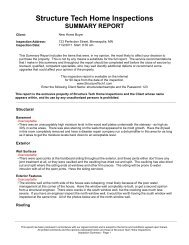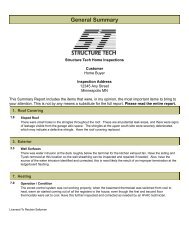2010 Hardiplank Lap Siding Installation Instructions
2010 Hardiplank Lap Siding Installation Instructions
2010 Hardiplank Lap Siding Installation Instructions
You also want an ePaper? Increase the reach of your titles
YUMPU automatically turns print PDFs into web optimized ePapers that Google loves.
<strong>Lap</strong> <strong>Siding</strong>INSTALLATION REQUIREMENTS - PRIMED & COLORPLUS ® PRODUCTSEFFECTIVE NOVEMBER <strong>2010</strong>Visit www.jameshardie.com for the most recent version.© ©IMPORTANT: FAILURE TO INSTALL AND FINISH THIS PRODUCT IN ACCORDANCE WITH APPLICABLE BUILDING CODES AND JAMES HARDIEWRITTEN APPLICATION INSTRUCTIONS MAY LEAD TO PERSONAL INJURY, AFFECT SYSTEM PERFORMANCE, VIOLATE LOCAL BUILDING CODES, ANDVOID THE PRODUCT ONLY WARRANTY. BEFORE INSTALLATION, CONFIRM THAT YOU ARE USING THE CORRECT HARDIEZONE TM PRODUCTS INSTRUCTIONS.TO DETERMINE WHICH HARDIEZONE TM APPLIES TO YOUR LOCATION, VISIT WWW.HARDIEZONE.COM OR CALL 1-866-942-7343 (866 9HARDIE)STORAGE & HANDLING:Store flat and keep dry andcovered prior to installation. Installingsiding wet or saturated may result inshrinkage at butt joints. Carry plankson edge. Protect edges and cornersfrom breakage. James Hardie is notresponsible fordamage causedby improperstorage andhandling of the product.OUTDOORSINDOORS1. Position cutting station so that wind will blow dust away from userand others in working area.2. Use one of the following methods:a. Best: i. Score and snapii. Shears (manual, electric or pneumatic)b. Better: i. Dust reducing circular saw equipped with aHardieBlade ® saw blade and HEPA vacuum extractionc. Good: i. Dust reducing circular saw with a HardieBlade saw blade(only use for low to moderate cutting)Figure 2water-resistivebarrierjointflashing**studNail 3/8" fromedge of plankinstall planks inmoderate contact at butt jointsCUTTING INSTRUCTIONSNail line(If nail line is notpresent place fastenerbetween ≤3/4" & 1” fromtop of plank)1. Cut only using score and snap, or shears (manual, electric or pneumatic).2. Position cutting station in well-ventilated area- NEVER use a power saw indoors- NEVER use a circular saw blade that does not carry the HardieBlade saw blade trademark- NEVER dry sweep – Use wet suppression or HEPA VacuumImportant Note: For maximum protection (lowest respirable dust production), James Hardie recommends always using “Best”-level cutting methods where feasible.NIOSH-approved respirators can be used in conjunction with above cutting practices to further reduce dust exposures. Additional exposure information is availableat www.jameshardie.com to help you determine the most appropriate cutting method for your job requirements. If concern still exists about exposure levels or youdo not comply with the above practices, you should always consult a qualified industrial hygienist or contact James Hardie for further information.SD083105IMPORTANT: To prevent damage to the drip edge, extra care should be taken when removing planks from the pallet,while handling, and when installing with a lap gauge. Please see additional handling requirements on page 4.GENERAL REQUIREMENTS:• HardiePlank ® lap siding can be installed over braced wood or steel studs spaced a maximum of 24" o.c. or directly to minimum 7/16" thick OSBsheathing. Irregularities in framing and sheathing can mirror through the finished application.• HardiePlank lap siding can also be installed over foam insulation/sheathing up to 1" thick. When using foam insulation/sheathing, avoid over-driving nails(fasteners), which can result in dimpling of the siding due to the compressible nature of the foam insulation/sheathing. Extra caution is necessary ifpower-driven nails (fasteners) are used for attaching siding over foam insulation/sheathing.• A water-resistive barrier is required in accordance with local building code requirements. The water-resistive barrier must be appropriately installed with penetration andjunction flashing in accordance with local building code requirements. James Hardie will assume noresponsibility for water infiltration. James Hardie does manufacture HardieWrap ® Weather Barrier, anon-woven non-perforated housewrap¹, which complies with building code requirements.• When installing James Hardie products all clearance details in figs. 3,4,5,6,7,8,& 9must be followed.• Adjacent finished grade must slope away from the building in accordance with localbuilding codes - typically a minimum of 6" in the first 10'.• Do not use HardiePlank lap siding in Fascia or Trim applications.• Do not install James Hardie products, such that they may remain in contact with standing water.• HardiePlank lap siding may be installed on flat vertical wall applications only.• DO NOT use stain on James Hardie ® products.• For larger projects, including commercial and multi-family projects, where the span of the wallis significant in length, the designer and/or architect should take into consideration thecoefficient of thermal expansion and moisture movement of the product in their design. Thesevalues can be found in the Technical Bulletin “Expansion Characteristics of James Hardie ®<strong>Siding</strong> Products” at www.JamesHardie.com.INSTALLATION:JOINT TREATMENT†(Required for ColorPlus ®Finish, Recommended forPrimed product) James Hardiedoes not recommend the use HardieZoneof caulk at field butt joints.HardiePlank ® sidingInstall factory finished edgestogether at butt joints.Double WallConstructionSingle WallConstructionwater-resistive barrierlet-in bracingplywood or24" o.c. max.OSB sheathingFigure 1*For other jointing options, refer to local building code or NER 405**As required by local building code ***Apply caulk in accordance with caulk manufacturers written application instructions¹For additional information on HardieWrap ® Weather Barrier, consult James Hardie at 1-866-4Hardie or www.hardiewrap.comleave appropriate gap betweenplanks and trim, then caulk***water-resistivebarrierfastenerInstall a 1 1/4" starter strip toensure a consistent plank angleWARNING: AVOID BREATHING SILICA DUSTJames Hardie ® products contain respirable crystalline silica, which is known to the State of California to cause cancer and is considered by IARC and NIOSH to be a cause of cancer from some occupationalsources. Breathing excessive amounts of respirable silica dust can also cause a disabling and potentially fatal lung disease called silicosis, and has been linked with other diseases. Some studies suggestsmoking may increase these risks. During installation or handling: (1) work in outdoor areas with ample ventilation; (2) use fiber cement shears for cutting or, where not feasible, use a HardieBlade sawblade and dust-reducing circular saw attached to a HEPA vacuum; (3) warn others in the immediate area; (4) wear a properly-fitted, NIOSH-approved dust mask or respirator (e.g. N-95) in accordance withapplicable government regulations and manufacturer instructions to further limit respirable silica exposures. During clean-up, use HEPA vacuums or wet cleanup methods - never dry sweep. For furtherinformation, refer to our installation instructions and Material Safety Data Sheet available at www.jameshardie.com or by calling 1-800-9HARDIE (1-800-942-7343). FAILURE TO ADHERE TO OURWARNINGS, MSDS, AND INSTALLATION INSTRUCTIONS MAY LEAD TO SERIOUS PERSONAL INJURY OR DEATH.SD050905HS0914-P1/4 1/10
CLEARANCESInstall siding and trim products in compliancewith local building code requirements forclearance between the bottom edge of thesiding and the adjacent finished grade.Figure 3water-resistivebarrierstudMaintain a 2" mininumclearance between JamesHardie ® products andpaths, steps anddriveways.Figure 4Maintain a 2" minimum clearancebetween James Hardie productsand decking material.Figure 5sidingwaterresistivebarrierAt the juncture of the roof and verticalsurfaces, flashing and counterflashingshall be installed per the roofingmanufacturer’s instructions. Provide a2" minimum clearance between theroofing and the bottom edge of thesiding and trim.Figure 6concretefoundation2" min.deck material2" min.2" min.Maintain a 1/4" clearancebetween the bottom ofJames Hardie productsand horizontal flashing.Do not caulk gap.Figure 7sidingDo not 1/4" gapCaulkflashing6" min.HardiePlank ®lap sidingsidingMaintain a minimum 1" gapbetween gutter end caps andsiding & trim.Figure 81"gutter and end capFigure 9Step flashingSelf-adheringmembraneHousewrapSelf-adheringeaves membraneKickoutflashingFASTENER REQUIREMENTS **Blind Nailing is the preferred method of installation for all HardiePlank ® lap siding productsfasciajoistDrip edgeflashingledgerflashingKICKOUT FLASHINGBecause of the volume of water that can pourdown a sloped roof, one of the most criticalflashing details occurs where a roof intersects asidewall. The roof must be flashed with stepflashing. Where the roof terminates, install akickout to deflect water away from the siding.It is best to install a self-adhering membrane onthe wall before the subfascia and trim boardsare nailed in place, and then come back toinstall the kickout.Figure 9, Kickout Flashing To prevent water from dumping behind the siding andthe end of the roof intersection, install a "kickout" of sufficient length and angle todirect the water running down the roof away from the siding.BLIND NAILINGNails - Wood Framing• <strong>Siding</strong> nail (0.09" shank x 0.221" HD x 2" long)• 11ga. roofing nail (0.121" shank x 0.371" HD x 1.25" long)Screws - Steel Framing• Ribbed Wafer-head or equivalent (No. 8 x 1 1/4" longx 0.375" HD) Screws must penetrate 3 threads into metal framing.Nails - Steel Framing• ET & F Panelfast ® nails or equivalent (0.10" shank x 0.313" HD x 1-1/2" long)Nails must penetrate minimum 1/4" into metal framing.OSB minimum 7/16"• 11ga. roofing nail (0.121" shank x 0.371" HD x 1.75" long)• Ribbed Wafer-head or equivalent (No. 8 x 1 5/8" long x 0.375" HD).FACE NAILINGNails - Wood Framing• 6d (0.113" shank x 0.267" HD x 2" long)• <strong>Siding</strong> nail (0.09” shank x 0.221” HD x 2” long)Screws - Steel Framing• Ribbed Bugle-head or equivalent (No. 8-18 x 1-5/8" long x0.323" HD) Screws must penetrate 3 threads into metal framing.Nails - Steel Framing• ET & F pin or equivalent (0.10" shank x 0.25" HD x 1-1/2" long)Nails must penetrate minimum 1/4" into metal framing.OSB minimum 7/16"• <strong>Siding</strong> nail (0.09" shank x 0.221" HD x 1-1/2" long)*Stud24”O.C. maxFigure 10Figure 11Minimum overlapfor Both Faceand Blind NailingJointFlashingStud24”O.C. max1 1/4” min.OverlapNail Line3/4”-1”min. 1 1/4"overlapFace NailBlind NailWater ResistiveBarrierWater ResistiveBarrier1 1/4” min.OverlapLaminate sheet to be removed immediately after installation of each course for ColorPlus ® products.The illustration (figure 9) and associated text was reprinted with permission of THE JOURNAL OF LIGHT CONSTRUCTION. For subscription information, visit www.jlconline.com.* When face nailing to OSB, planks must be no greater than 9 1/4" wide and fasteners must be 12" o.c. or less.** Also see General Fastening Requirements; and when considering alternative fastening options refer to James Hardie's Technical Bulletin USTB 17 - Fastening Tips for HardiePlank ® <strong>Lap</strong> <strong>Siding</strong>.HS0914-P2/4 1/10
GENERAL FASTENING REQUIREMENTSFasteners must be corrosion resistant, galvanized, or stainless steel.Electro-galvanized are acceptable but may exhibit premature corrosion.James Hardie recommends the use of quality, hot-dipped galvanizednails. James Hardie is not responsible for the corrosion resistance offasteners. Stainless steel fasteners are recommended when installingJames Hardie ® products near the ocean, large bodies of water, or invery humid climates.PNEUMATIC FASTENINGJames Hardie products can be hand nailed or fastened with apneumatic tool. Pneumatic fastening is highly recommended. Set airpressure so that the fastener is driven snug with the surface of thesiding. A flush mount attachment on the pneumatic tool is recommended.This will help control the depth the nail is driven. If settingthe nail depth proves difficult, choose a setting that under drives thenail. (Drive under driven nails snug with a smooth faced hammer -Does not apply for installation to steel framing).CUT EDGE TREATMENTCaulk, paint or prime all field cutedges.• Consult applicable code compliance report for correct fasteners type andplacement to achieve specified design wind loads.• NOTE: Published wind loads may not be applicable to all areas whereLocal Building Codes have specific jurisdiction. Consult James HardieTechnical Services if you are unsure of applicable compliance documentation.• Drive fasteners perpendicular to siding and framing.• Fastener heads should fit snug against siding (no air space). (fig. A )• Do not over-drive nail heads or drive nails at an angle.• If nail is countersunk, caulk nail hole and add a nail. (fig. B)• For wood framing, under driven nails should be hit flush to the plank with ahammer (For steel framing, remove and replace nail).• Do not use aluminum fasteners, staples, or clipped head nails.PAINTINGDO NOT use stain on James Hardie ® products.James Hardie products must be painted within 180days for primed product and 90 days for unprimed.100% acrylic topcoats are recommended.Do not paint when wet. For application rates refer topaint manufacturers specifications.Back-rolling is recommended if the siding is sprayed.COLORPLUS ® TECHNOLOGY CAULKING, TOUCH-UP & LAMINATE• Touch up nicks, scrapes and nail heads using the ColorPlus ® Technology touch-up applicator. Touch-up paint should be used sparingly.If large areas require touch-up, replace the damaged area with new HardiePlank ® lap siding with ColorPlus ® Technology.• Laminate sheet must be removed immediately after installation of each course.• Terminate non-factory cut edges into trim where possible, and caulk. Color matched caulks are available from your ColorPlus ® product dealer.• Treat all other non-factory cut edges using the ColorPlus Technology edge coaters, available from your ColorPlus product dealer.COVERAGE CHART/ESTIMATING GUIDENumber of 12' planks, does not include wasteSQ(1 SQ = 100 sq.ft.)12345678910111213141516171819205 1/442550751001251501752002252502753003253503754004254504755006 1/45204060801001201401601802002202402602803003203403603804007 1/461733506783100117133150167183200217233250267283300317333Figure ACAULKINGFor best results use an Elastomeric Joint Sealantcomplying with ASTM C920 Grade NS, Class 25 orhigher or a Latex Joint Sealant complying with ASTMC834. Caulking/Sealant must be applied in accordancewith the caulking/sealant manufacturer’s writteninstructions or ASTM C1193.PAINTING JAMES HARDIE ® SIDING AND TRIM PRODUCTS WITH COLORPLUS ® TECHNOLOGYWhen repainting ColorPlus products, James Hardie recommends the following regarding surface preparation and topcoat application:• Ensure the surface is clean, dry, and free of any dust, dirt, or mildew• Repriming is normally not necessary• 100% acrylic topcoats are recommended• DO NOT use stain or oil/alkyd base paints on James Hardie ® products• Apply finish coat in accordance with paint manufacturers written instructions regarding coverage, application methods, and application temperatureHARDIEPLANK ® LAP SIDING WIDTHThis coverage chart is meant as a guide. Actual usage is subject to variables such as building design. James Hardie does not assume responsibilityfor over or under ordering of product.RECOGNITION: In accordance with ICC-ES Legacy Report NER-405, HardiePlank ®lap siding is recognized as a suitable alternate to that specified in: the BOCA National Building Code/1999, the 1997 StandardBuilding Code, the 1997 Uniform Building Code, the 1998 International One- and Two-Family Dwelling Code, the 2003 International Building Code, and the 2003 International Residential Code for One-and Two-Family Dwellings. HardiePlank lap siding is also recognized for application in the following: City of Los Angeles Research Report No. 24862, State of Florida listing FL#889, Dade County, Florida NOA No. 02-0729.02,U.S. Dept. of HUD Materials Release 1263c, Texas Department of Insurance Product Evaluation EC-23, City of New York MEA 223-93-M, and California DSA PA-019. These documents should also be consulted foradditional information concerning the suitability of this product for specific applications.7 1/26 1/416324864809611212814416017619220822424025627228830432086 3/41530445974891041191331481631781932072222372522672812968 1/47142943577186100114129143157171186200214229243257271286Figure B9 1/48132538506375881001131251381501631751882002132252382509 1/28 1/4132538506375881001131251381501631751882002132252382501210 3/49192837475665748493102112121130140149158167177186HS0914-P3/4 1/10
ADDITIONAL HANDLING REQUIREMENTSIMPORTANT: To prevent damage to the drip edge, extra care should be taken when removing planks from the pallet, while handling, and wheninstalling with a lap gauge. Planks are interlocked together on the pallet, therefore they should be removed from the pallet horizontally (side toside) to allow planks to unlock themselves from one another.Pull from across the stackDo not go down the stack© <strong>2010</strong> James Hardie Technology Limited. All rights reserved.TM, SM, and ® denote trademarks or registered trademarks ofJames Hardie Technology Limited. is a registered trademarkof James Hardie Technology Limited.Panelfast is a registered trademark of ET&F Fastening Systems, Inc.Additional <strong>Installation</strong> Information,Warranties, and Warnings are available atwww.jameshardie.comHS0914-P4/4 1/10










